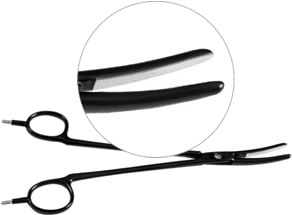gastrology
gynecology
- vaginal hysterectomy
- abdominal hysterectomy
- laparoscopic hysterectomy
vaginal hysterectomy
with the use of ThermoStapler®
 Incision of the vaginal mucosa. Directing the uterus to the vagina in order to expose the uterine ligaments.
Incision of the vaginal mucosa. Directing the uterus to the vagina in order to expose the uterine ligaments.
 Release of the uterine ligaments: subsequent tightening of the ThermoStapler® tool and closing tissue structures. After ligating the vessels the closed area should be cut with surgical scissors. The procedure should be repeated until the uterus is fully released.
Release of the uterine ligaments: subsequent tightening of the ThermoStapler® tool and closing tissue structures. After ligating the vessels the closed area should be cut with surgical scissors. The procedure should be repeated until the uterus is fully released.
 Sewing up the uterus stump with a running suture. The use of the ThermoStapler® bipolar vessel sealing system is an efficient and safe alternative to the classical trans-vaginal hysterectomy technique using surgical sutures.
Sewing up the uterus stump with a running suture. The use of the ThermoStapler® bipolar vessel sealing system is an efficient and safe alternative to the classical trans-vaginal hysterectomy technique using surgical sutures.
The ThermoStapler® vessel sealing system enables permanent sealing of large blood vessels and tissues during open and laparoscopic surgery.
The ThermoStapler® system, designed by EMED, is an alternative to the traditional vessel sealing method using many ligatures and staplers.
main advantages
- physical pressure onto the vessel with the use of a special bipolar instrument
- a generator administering high frequency and low voltage current which does not cause sparks during the sealing process
- constant monitoring of the tissue impedance during the process of sealing
- microprocessor control ensuring the repeated coagulation effect
- automatic switch-off of the generator at the moment of achieving the optimal sealing of the vessel, confirmed with a sound signal
- the possibility to select the level of intensity of the effect lower intensity means higher precision and depth of the coagulation, higher intensity means quicker final effect
- the possibility to connect two different ThermoStapler® instruments or to combine the vessel sealing technique with a traditional bipolar technique
accessories & instruments



top


